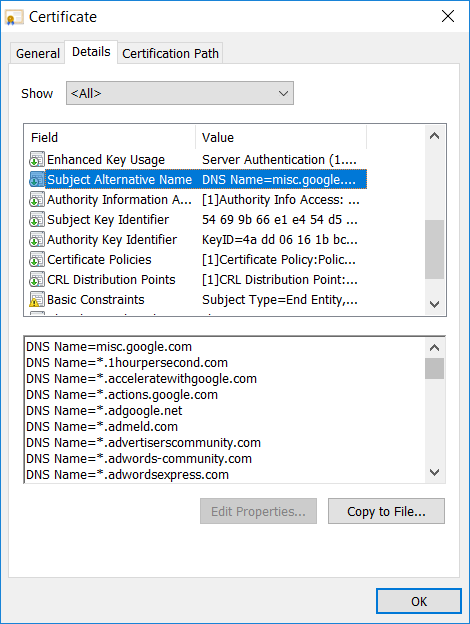For some reason, I had to combine three different sets of instructions to get a SAN added to my certificate. Getting the SAN into the request was easy enough … but actually carrying the extension through to the signed certificate was a significant challenge. There may be unnecessary changes in my custom config file, but this process worked.
cp /etc/pki/tls/openssl.cnf ./myssl.cnf
Edit the copied file (i.e. don’t change your OpenSSL default config)
# Uncomment:
copy_extensions = copy
# Uncomment:
req_extensions = v3_req # The extensions to add to a certificate request
# Add:
[ req_ext ]
subjectAltName = @alt_names
[ alt_names ]
DNS.1 = exchange01.rushworth.us
DNS.2 = exchange01
Save the file and we’re ready to create a certificate. Make a key
openssl genrsa -aes256 -out exchange01.rushworth.us.key 2048
Then create the cert request using the copied config file. Include the -reqexts option with value of the section of your custom file that includes subjectAltName (e.g. it is called req_ext in my cnf file, so I used -reqexts req_ext)
openssl req -new -key exchange01.rushworth.us.key -config ./myssl.cnf -reqexts req_ext -out exchange01.rushworth.us.csr
Sign the request against your CA – again using the custom config file and req_ext extensions
openssl x509 -req -in exchange01.rushworth.us.csr -extensions req_ext -extfile ./myssl.cnf -out exchange01.rushworth.us.cer -days 365 -CA /ca/ca.cer -CAkey /ca/ca.key -sha256
Before doing anything else, verify that your SAN values are in the certificate
[lisa@linux02]# openssl x509 -in exchange01.rushworth.us.cer -text | grep -A1 Alternative
X509v3 Subject Alternative Name:
DNS:exchange01.rushworth.us, DNS:exchange01
If you are using the certificate in something that understands PEM nodes, you are set. If you are trying to get a certificate for a Windows server, create a PFX export of the public/private key pair and then import the PFX to your computer’s personal certificate store.
openssl pkcs12 -export -out exchange01.rushworth.us.pfx -inkey exchange01.rushworth.us.key -in exchange01.rushworth.us.cer
